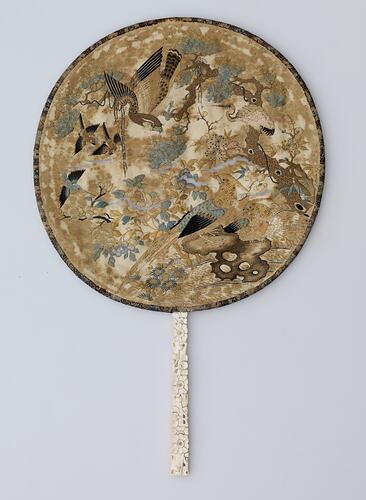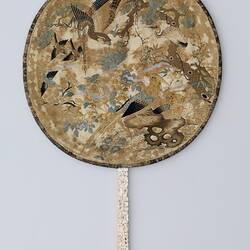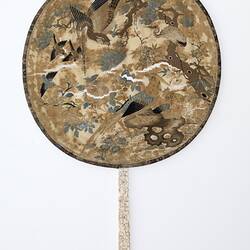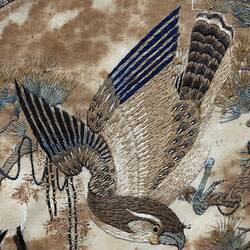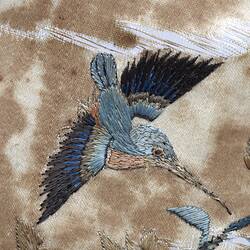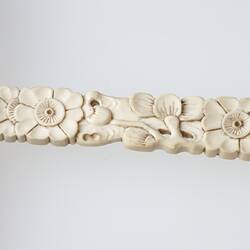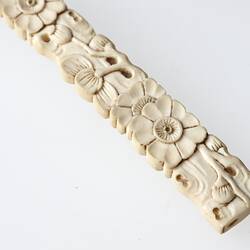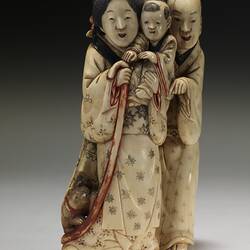Summary
Intricately embroidered silk fan depicting birds, flowers amidst a background of fir trees, with ornately carved ivory stem, manufactured in China during the late Qing Dynasty (1644-1912), circa 1880.
The form of the round fan ('Tuan Shan', in Chinese) is one of the most recognisable fan shapes in Chinese culture, dating back to the Han Dynasty (202BC - 204AD). They were used by both men and women through until the Ming Dynasty (1468-1644), at which point changes in fashion saw the round fan become almost exclusively a female fashion accessory.
Although for the fan's shape is often round, it could also be rectangular, square, or have rounded edges. As with many forms of Asian art, the fans' shape and the scenes and motifs with which they were decorated were often rich in meaning. The circular shape, like a full moon, represented the joy at bringing the family together for the Full Moon festival - an important and auspicious occasion in the Chinese calendar - while the Chinese word for round - 'tuan' - could also mean 'unite', again relating to the ideas of union and happiness associated with the Full Moon. Women would often conceal their faces with the fan, giving this style of fan one of its other names, 'Zhang Mian' - 'hiding face'.
With the rise in popularity of 'Chinoiserie' (in the Chinese-style) in European decorative arts in the late seventeenth and eighteenth centuries, small items such as fans became a means to export Chinese culture to the West.
Physical Description
Silk circular fan embroidered with birds and flowers. Ivory handle, carved with flowers and leaves. Very worn and faded. Traces of paper backing around rim on back. No markings.
More Information
-
Collection Names
-
Collecting Areas
-
Acquisition Information
Cultural Gifts Donation from Dr Will Twycross, 23 Jan 2009
-
Acknowledgement
Donated through the Australian Government's Cultural Gifts Program
-
Place & Date Made
-
Place & Date Exhibited
Royal Exhibition Building (REB), Nicholson Street, Carlton, Greater Melbourne, Victoria, Australia, 1880-1881
-
Collector
Mr John Twycross, Elsternwick, Greater Melbourne, Victoria, Australia, 1881
-
Classification
Royal exhibition building, International exhibitions, Exhibition heritage
-
Category
-
Discipline
-
Type of item
-
Overall Dimensions
270 mm (Width), 5 mm (Depth), 415 mm (Height)
-
References
Tsnag, Ka Bo, 'More than Keeping Cool: Chinese Fans and Fan Paintings', Toronto: Royal Ontario Museum, 2002. Qian, Gonglin, 'Chinese fans: artistry and aesthetics', Long River Press, 2000.
-
Keywords
Exhibitions: Melbourne International, 1880-1881, Fans, Ivory, Japanese Art, Royal Exhibition Building, Silk Fabrics & Textiles
